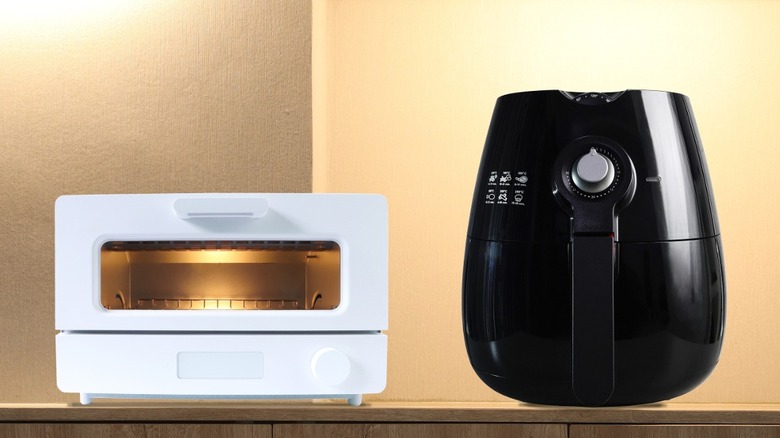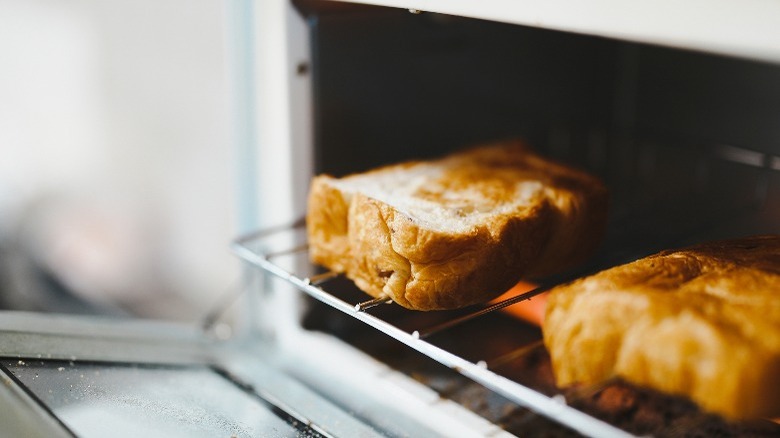Toaster Oven Vs Air Fryer: What's The Difference?
Toaster ovens and air fryers are among the most versatile countertop appliances. Both help you streamline cooking and heat your kitchen less than a regular oven. And they're both fantastic options for busy weeknight dinners. However, they function differently and have distinct strengths and weaknesses. Understanding how they work and what they're good at can help you decide which one to invest in first and which one's the right fit for a given task.
Air fryers use convection — a scientific term used to describe the transfer of heat via moving air — to cook food rapidly and evenly, mimicking the results of deep-frying in many ways (and thus the comparison). While some newer toaster ovens may have convection settings, they're known for cooking by radiant heat (just blasting it with stagnant heat) from top and bottom heating elements. Both are technically mini-ovens, albeit different types of mini-ovens.
If you have to choose, think about how you cook. Air fryers are best for "frying," baking, and roasting without (much) oil. Toaster ovens can bake and roast, though they require traditional amounts of oil. They can't "fry" anything, but they can melt cheese without it blowing up into the elements and generally can handle larger foods, such as a whole chicken or frozen pizza.
Air fryers
Air fryers are fast and efficient. Rapid air circulation cooks food faster and more evenly. These gadgets are usually set up to allow maximum airflow on all sides, requiring you to set the food on a perforated surface or rack with plenty of room for airflow. That's ideal if you want food in a hurry, whether it's a quick snack or lunch for the work-from-home crowd. But its pièce de résistance is crispy food. It can reheat or cook foods like fried chicken, roasted potatoes, garlic toast, frozen mozzarella sticks, or pizza rolls to crispy perfection in a matter of minutes with little to no oil, resulting in fewer calories from fat in all your guilty-pleasure foods.
It is, however, best used for small portions thanks to the petite size of the gadget's food preparation area. And while it does an outstanding job with foods that benefit from crisping or recrisping, convection can be a drying environment for foods that benefit from moisture, so there are some foods you shouldn't make in an air fryer. Plus, the fan is really powerful, so you must be careful that food and cooking helpers like foil and parchment don't fly into the cooking element.
Toaster ovens
Toaster ovens are workhorses. They do anything your range oven can do, just on a smaller scale, which is plenty of room for many cooks. Some may even have convection (air fry) settings, though they are typically more expensive than air fryers. Almost all are bigger than a standard air fryer, too, and the larger capacity allows you to cook larger portions or even make an entire roast dinner at once, though it also means they take up more space on the countertop. They're also more versatile than an air fryer, allowing them to more easily sub for a full-size oven. They just won't air fry or do an oil-free roast without convection.
Depending on your cooking needs, either appliance is a valuable addition to your kitchen. Air fryers provide small, quick meals that are crisped to perfection, while toaster ovens offer more versatility, cooking much like a range oven while handling more food than an air fryer. When deciding which to buy (or buy first), think about the types of cooking tasks you'd like it to handle. Then, price out models based on the size and features you want in each.


